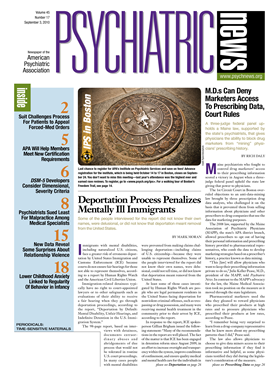Nearly 40 percent of people with a history of major depression also report symptoms of subthreshold hypomania, indicating the potential for bipolar disorder.
This subgroup also appears to have a younger age at onset, more episodes of depression, and higher rates of comorbidity with anxiety and substance use disorders than those without a history of hypomania, while having lower levels of clinical severity than those with bipolar II disorder.
The findings were based on an analysis of the National Comorbidity Survey–Replication (NCS-R) published online in AJP in Advance on August 16.
“If people have repeated brief episodes of hypomania in the context of major depression, they may actually suffer from bipolar disorder rather than only major depression,” lead author Kathleen Merikangas, Ph.D., told Psychiatric News. “Therefore, clinicians should monitor them closely for the development of threshold-level manic episodes and their consequences.”
Merikangas is senior investigator and chief of the Genetic Epidemiology Research Branch at the National Institute of Mental Health.
She said that in the NCS-R analysis subthreshold mania was associated with an earlier age of onset of depression, more coexisting mental health problems, more episodes of depression, more suicide attempts, and a stronger family history of bipolar disorder.
The NCS-R is a nationally representative face-to-face household survey of the prevalence and correlates of a wide range of DSM-IV mental disorders that was carried out between February 2001 and April 2003. Mood disorders (bipolar I disorder, bipolar II disorder, and unipolar depression) were diagnosed using DSM-IV criteria.
Criteria for subthreshold hypomania included a positive response to at least one of the following screening questions, along with failure to meet the full diagnostic criteria for hypomania:
•.
“Some people have periods lasting several days or longer when they feel much more excited and full of energy than usual. Their minds go too fast. They talk a lot. They are very restless or unable to sit still, and they sometimes do things that are unusual for them, such as driving too fast or spending too much money. Have you ever had a period like this lasting several days or longer?” or
•.
“Have you ever had a period lasting several days or longer when most of the time you were so irritable that you either started arguments, shouted at people, or hit people?”
If respondents gave a positive answer to either of these questions, the entire mania module of the World Health Organization's Composite International Diagnostic Interview was administered, and respondents were then queried about 15 symptoms of mania. Those who endorsed three or more symptoms were asked about the duration, age at onset, recurrence, frequency, severity, and impairment.
The researchers found that of respondents who had a history of major depression, 38.8 percent also reported symptoms of subthreshold hypomania in the preceding 12 months. Compared with those with major depression alone, those with major depression and subthreshold hypomania had greater rates of comorbidity with anxiety, substance use disorders, and behavioral problems.
Merikangas said the results underscore much recent evidence suggesting the heterogeneity of mood disorders.
“Mania is manifest on a spectrum ranging from brief episodes of increased activity and energy without impairment, or even enhanced functioning, to severe extended periods of mania associated with severe functional impairment,” she told Psychiatric News. “The dimensional versus categorical approaches to classification have long been debated, but evidence suggests that a combination of the two provides the best characterization of clinical depression. Recent international research suggests that both manic and depressive symptoms are best represented as dimensions with thresholds for clinical significance defined by impairment and severity of consequences or subjective distress.
“The other important discovery in recent research is that mania in the population may be better recognized as a discrete change in activity level rather than by euphoria or elation. In fact, mania may be experienced as agitation rather than as euphoria.”
